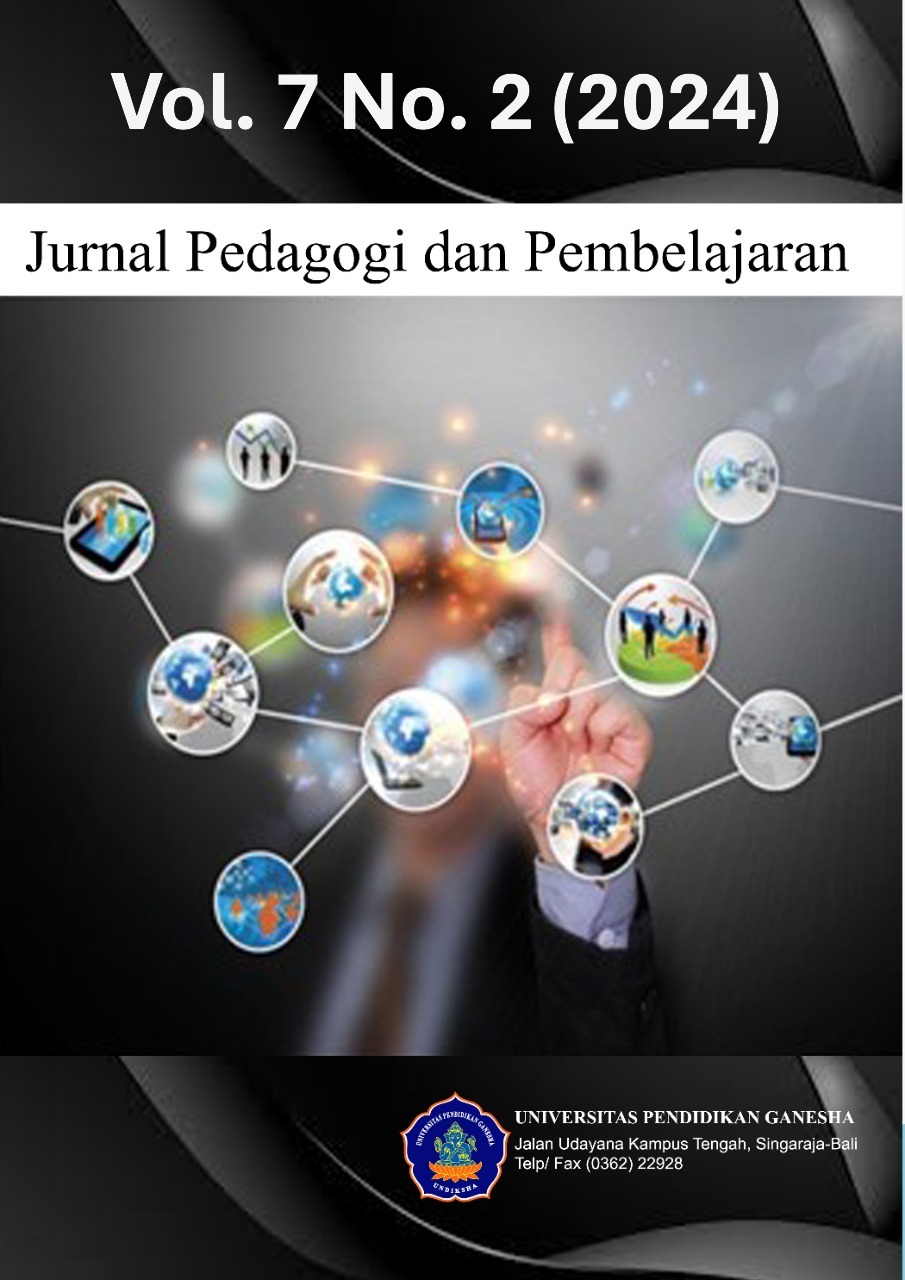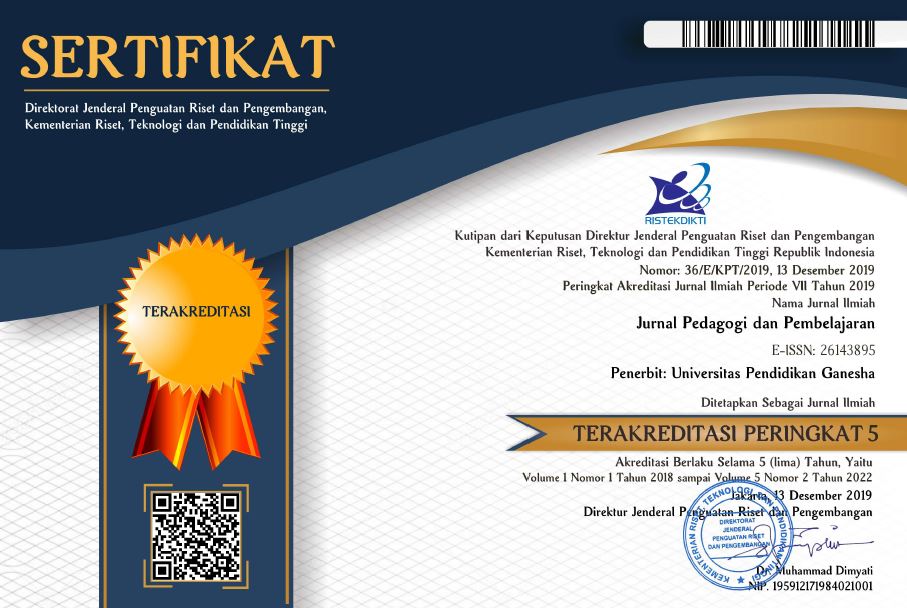Workload as Determinant of Teachers’ Job Satisfaction in Public Secondary Schools
DOI:
https://doi.org/10.23887/jp2.v7i2.70465Keywords:
Workload, Teachers’ Job Satisfaction, Classroom SizeAbstract
It has been observed that several teachers are leaving the teaching profession not because of poor salaries but because of a lack of job satisfaction. This study aims to analyze workload as a determinant of teachers’ job satisfaction in public secondary schools in Oyo State, Nigeria. The descriptive survey research design was used. Three research questions were raised to guide the study. The study used a sample size determination to select 183 schools and 1,363 teachers. The research instrument used a self-designed questionnaire titled ‘Workload and Teachers’ Job Satisfaction Questionnaire was analyzed using frequency, counting, percentage, mean and standard deviation. The findings of the study provide valuable insights into the impact of workload on teachers' job satisfaction. The study found that as workload increases, job satisfaction decreases. This suggests that high levels of workload negatively affect teachers' overall satisfaction with their jobs. The results also revealed that teachers in public secondary schools in Oyo State are facing a heavy workload. It can be concluded that there is a significant correlation between workload and job satisfaction among teachers in public secondary schools in Oyo State. It was recommended that the school workload of the teachers in terms of working time and class size should be well maximized in other to improve the teachers’ job satisfaction.
References
Abuhmaid, A. (2011). ICT training courses for teacher professional development in jordan. Turkish Online Journal of Educational Technology, 10(4). https://eric.ed.gov/?id=EJ946628.
Agustina, M., Kristiawan, M., & Tobari, T. (2020). The Influence of Principal’s Leadership and School’s Climate on The Work Productivity of Vocational Pharmacy Teachers in Indonesia. International Journal of Educational Review, 3(1), 63–76. https://doi.org/10.33369/ijer.v3i1.11858. DOI: https://doi.org/10.33369/ijer.v3i1.11858
Ayanwale, M. A., Sanusi, I. T., Adelana, O. P., Aruleba, K. D., & Oyelere, S. S. (2022). Teachers’ readiness and intention to teach artificial intelligence in schools. Computers and Education: Artificial Intelligence, 3(June), 100099.1-11. https://doi.org/10.1016/j.caeai.2022.100099. DOI: https://doi.org/10.1016/j.caeai.2022.100099
Azhari, R., & Wicaksono, A. H. (2017). Manajemen Pembinaan Karir Sumber Daya Manusia dalam Pendidikan Islam. At-Ta’dib. https://doi.org/10.21111/at-tadib.v12i2.1166. DOI: https://doi.org/10.21111/at-tadib.v12i2.1166
Bilqis, Syachruroji, A., & Taufik, M. (2016). Perbedaan Hasil Belajar Siswa pada Mata Pelajaran Ilmu Pengetahuan Alam antara Model Problem Based Learning dengan Model Pembelajaran Langsung. JPSD (Jurnal Pendidikan Sekolah Dasar), 2(2), 147–155. https://doi.org/10.30870/jpsd.v2i2.794.
Bobga, T. N. J. (2016). An Appraisal of Effective Provision of Guidance and Counselling Services in Cameroon State Universities: Trends and Challenges. IJHSSE: International Journal of Humanities Social Sciences and Education, 3(9), 75–90. https://esciencepress.net/journals/index.php/IJES/article/view/2542. DOI: https://doi.org/10.20431/2349-0381.0309010
Cheng, E. W. L. (2016). Maintaining the transfer of in-service teachers’ training in the workplace. Educational Psychology, 36(3). https://doi.org/10.1080/01443410.2015.1011608. DOI: https://doi.org/10.1080/01443410.2015.1011608
Chughati, F. D., & Perveen, U. (2013). A study of teachers workload and job satisfaction in public And private schools at secondary level in Lahore city Pakistan. Asian Journal of Social Sciences & Humanities, 2(1), 202–214. http://www.ajssh.leena-luna.co.jp/AJSSHPDFs/Vol.2(1)/AJSSH2013(2.1-22).pdf.
Gill, A. N., Ilyas, M. A., Awan, R. A., & Raza, M. (2021). Role Ambiguity And Role Conflict On Organizational Performance In Telecommunication Sector: Taking Job Satisfaction As A Mediator. PalArch’s Journal of Archaeology of Egypt / Egyptology, 18(10), 1215–1228. https://archives.palarch.nl/index.php/jae/article/view/9988.
Hennessy, S., D’Angelo, S., McIntyre, N., Koomar, S., Kreimeia, A., Cao, L., Brugha, M., & Zubairi, A. (2022). Technology Use for Teacher Professional Development in Low- and Middle-Income Countries: A systematic review. Computers and Education Open, 3(February), 100080.1-32. https://doi.org/10.1016/j.caeo.2022.100080. DOI: https://doi.org/10.1016/j.caeo.2022.100080
Hidayat, R., & Patras, Y. E. (2022). The Effect of Organizational Trust and Job Satisfaction on Teachers’ Organizational Citizenship Behavior (OCB) in Private Senior High Schools. AL-TANZIM: Jurnal Manajemen Pendidikan Islam, 6(4), 1049–1063. https://doi.org/10.33650/al-tanzim.v6i4.3488. DOI: https://doi.org/10.33650/al-tanzim.v6i4.3488
Jeffri, N. F. S., & Awang Rambli, D. R. (2021). A review of augmented reality systems and their effects on mental workload and task performance. In Heliyon (Vol. 7, Issue 3). https://doi.org/10.1016/j.heliyon.2021.e06277. DOI: https://doi.org/10.1016/j.heliyon.2021.e06277
Koedel, C., Li, J., Springer, M. G., & Tan, L. (2017). The Impact of Performance Ratings on Job Satisfaction for Public School Teachers. American Educational Research Journal, 54(2), 241–278. https://doi.org/10.3102/0002831216687531. DOI: https://doi.org/10.3102/0002831216687531
Kuosa, K., Distante, D., Tervakari, A., Cerulo, L., Fernández, A., Koro, J., & Kailanto, M. (2016). Interactive visualization tools to improve learning and teaching in online learning environments. International Journal of Distance Education Technologies, 14(1), 1–21. https://doi.org/10.4018/IJDET.2016010101. DOI: https://doi.org/10.4018/IJDET.2016010101
Li, X., Nu, N., Yang, X., & Zeng, S. (2020). Green total factor productivity measurement and green technology capability spillover in western region of China. Environmental Engineering and Management Journal, 19(7), 1105–1114. https://doi.org/10.30638/eemj.2020.104. DOI: https://doi.org/10.30638/eemj.2020.104
Muthanna, A., & Alduais, A. (2021). A Thematic Review on Research Integrity and Research Supervision: Relationships, Crises and Critical Messages. Journal of Academic Ethics, 19(1), 95–113. https://doi.org/10.1007/s10805-020-09368-z. DOI: https://doi.org/10.1007/s10805-020-09368-z
Ndjangala, M. N. N., Abah, J., & Mashebe, P. (2021). Teachers’ views on challenges affecting learners’ performance in natural science. International Journal of Evaluation and Research in Education, 10(1), 48–56. https://doi.org/10.11591/ijere.v10i1.20732. DOI: https://doi.org/10.11591/ijere.v10i1.20732
Obiakor, M. I., & Oguejioffor, C. N. (2020). Impact of Classroom Size on Academic Performance of Secondary School Students in Enugu North Local Government Area of Enugu State, Nigeria. African Journal of Educational Management, Teaching and Entrepreneurship Studies, 1(1), 51–59. https://academicjournals.org/journal/AJEMATES/article-full-text-pdf/765CF8966410.
Ogwa, V. A. (2021). Guidance and counselling as coping strategies for security management. International Journal of Management Studies and Social Science Research, 20(3), 137–145. https://www.mdpi.com/1660-4601/20/3/1814.
Owoeye, J. S. & Yara, P. (2021). Class Size and Academic Achievement of Secondary School in Ekiti State, Nigeria. Asian Social Science, 7(6), 184–189. https://doi.org/10.5539/ass.v7n6p184 DOI: https://doi.org/10.5539/ass.v7n5p170
Özcan, M. (2021). Evaluation of Prospective Teachers’ Digital Literacy Levels and Mobile Learning Attitudes. Journal of Educational Technology and Online Learning, 5(2). https://doi.org/10.31681/jetol.1020586. DOI: https://doi.org/10.31681/jetol.1020586
Qodr, T. S., Efendi, A., & Musadad, A. A. (2021). Opportunities for Using Smartphones in the Digital Era to Facilitate Students in Learning Sociology in High Schools. Journal of Education Technology, 5(2), 263–271. https://doi.org/10.23887/jet.v5i2.34806. DOI: https://doi.org/10.23887/jet.v5i2.34806
Rodrigues, L. de A. D., de Pietri, E., Sanchez, H. S., & Kuchah, K. (2018). The role of experienced teachers in the development of pre-service language teachers’ professional identity: Revisiting school memories and constructing future teacher selves. International Journal of Educational Research, 88, 146–155. https://doi.org/10.1016/J.IJER.2018.02.002. DOI: https://doi.org/10.1016/j.ijer.2018.02.002
Seixas, B. V., Smith, N., & Mitton, C. (2018). The qualitative descriptive approach in international comparative studies: Using online qualitative surveys. International Journal of Health Policy and Management, 7(9), 778–781. https://doi.org/10.15171/ijhpm.2017.142. DOI: https://doi.org/10.15171/ijhpm.2017.142
Skaalvik, E. M., & Skaalvik, S. (2015). Job satisfaction, stress and coping strategies in the teaching profession-what do teachers say? International Education Studies, 8(3), 181–192. https://doi.org/10.5539/ies.v8n3p181. DOI: https://doi.org/10.5539/ies.v8n3p181
Susilawati, W. O., Widodo, H., & Sumarno, S. (2019). Strategy of Teachers in Suporting Environmentally Sustainable Development. Journal of Education and Learning (EduLearn), 13(2), 247–254. https://doi.org/10.11591/edulearn.v13i2.12167. DOI: https://doi.org/10.11591/edulearn.v13i2.12167
Wahyunianti Dahri, N., & Aqil, M. (2018). Budaya Organisasional, Kepuasan Kerja, dan Komitmen Organisasional dalam Meningkatkan Perilaku Inovatif. Jurnal Bisnis Teori Dan Implementasi, 9(2), 191–199. https://doi.org/10.18196/bti.92109. DOI: https://doi.org/10.18196/bti.92109
Wang, L., & Yu, Z. (2023). Gender-moderated effects of academic self-concept on achievement, motivation, performance, and self-efficacy: A systematic review. Frontiers in Psychology, 14. https://doi.org/10.3389/fpsyg.2023.1136141. DOI: https://doi.org/10.3389/fpsyg.2023.1136141
Weikamp, J. G., & Göritz, A. S. (2016). Organizational citizenship behaviour and job satisfaction: The impact of occupational future time perspective. Human Relations, 69(11), 2091–2115. https://doi.org/10.1177/0018726716633512. DOI: https://doi.org/10.1177/0018726716633512
Wood, S., Veldhoven, M. V., Croon, M., & DeMenezes, L. M. (2012). Enriched job design, high involvement management and organizational performance: the mediating roles of job satisfaction and well-being. Human Relations, 65(4), 1–27. https://doi.org/10.1177/00187267114324. DOI: https://doi.org/10.1177/0018726711432476
Wu, W., Berestova, A., Lobuteva, A., & Stroiteleva, N. (2021). An Intelligent Computer System for Assessing Student Performance. International Journal of Emerging Technologies in Learning, 16(2), 31–45. https://doi.org/10.3991/ijet.v16i02.18739. DOI: https://doi.org/10.3991/ijet.v16i02.18739
Yang, M., Fry, L. W., Wong, S., Supriyanto, A. S., Ekowati, V. M., Maghfuroh, U., Sholikhah, Z., Wang, X., Li, W., Sandra, D., Sadeghifar, J., Reiser, D., Pio, R. J., Lengkong, F. D. J., Oh, J., Wang, J., Nurabadi, A., Noori, H., Yaghoubi, N. M., … Vanesalafi, Y. N. (2020). Spiritual leadership values and organisational behaviour in Malaysian private institutions of higher education. International Journal of Innovation, Creativity and Change, 10(3), 495–507. https://doi.org/10.1108/JMD-07-2018-0186. DOI: https://doi.org/10.1108/JMD-07-2018-0186
Yoon, I., & Kim, M. (2022). Dynamic Patterns of Teachers’ Professional Development Participation and Their Relations with Socio-Demographic Characteristics, Teacher Self-Efficacy, and Job Satisfaction. Teaching and Teacher Education, 109, 103565. https://doi.org/10.1016/j.tate.2021.103565. DOI: https://doi.org/10.1016/j.tate.2021.103565
Downloads
Published
How to Cite
Issue
Section
License
Copyright (c) 2023 Adeseko Sunday Olaifa, Fausat Motunrayo Abisoye, Moses Adeleke Adeoye, Idowu Philip Ajewole, Ebunlomo Oreoluwa Olaifa

This work is licensed under a Creative Commons Attribution-ShareAlike 4.0 International License.
Authors who publish with Jurnal Pedagogi dan Pembelajaran agree to the following terms:
- Authors retain copyright and grant the journal the right of first publication with the work simultaneously licensed under a Attribution-ShareAlike 4.0 International (CC BY-SA 4.0) that allows others to share the work with an acknowledgment of the work's authorship and initial publication in this journal
- Authors are able to enter into separate, additional contractual arrangements for the non-exclusive distribution of the journal's published version of the work (e.g., post it to an institutional repository or publish it in a book), with an acknowledgment of its initial publication in this journal.
- Authors are permitted and encouraged to post their work online (e.g., in institutional repositories or on their website) prior to and during the submission process, as it can lead to productive exchanges, as well as earlier and greater citation of published work. (See The Effect of Open Access)











